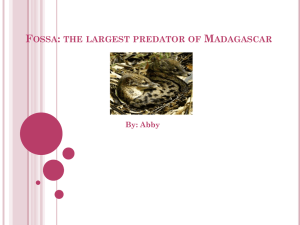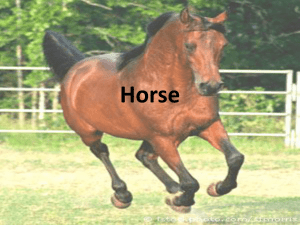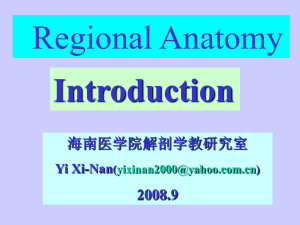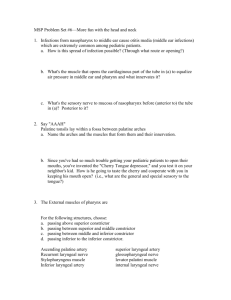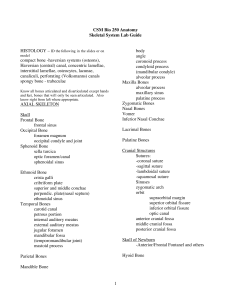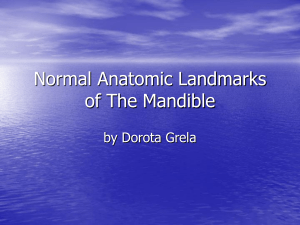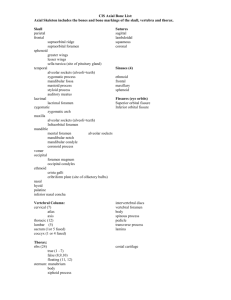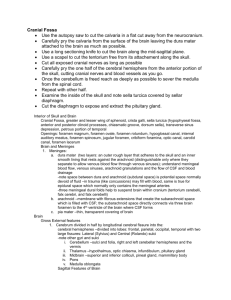Anth 690 Advanced Human Osteology
advertisement
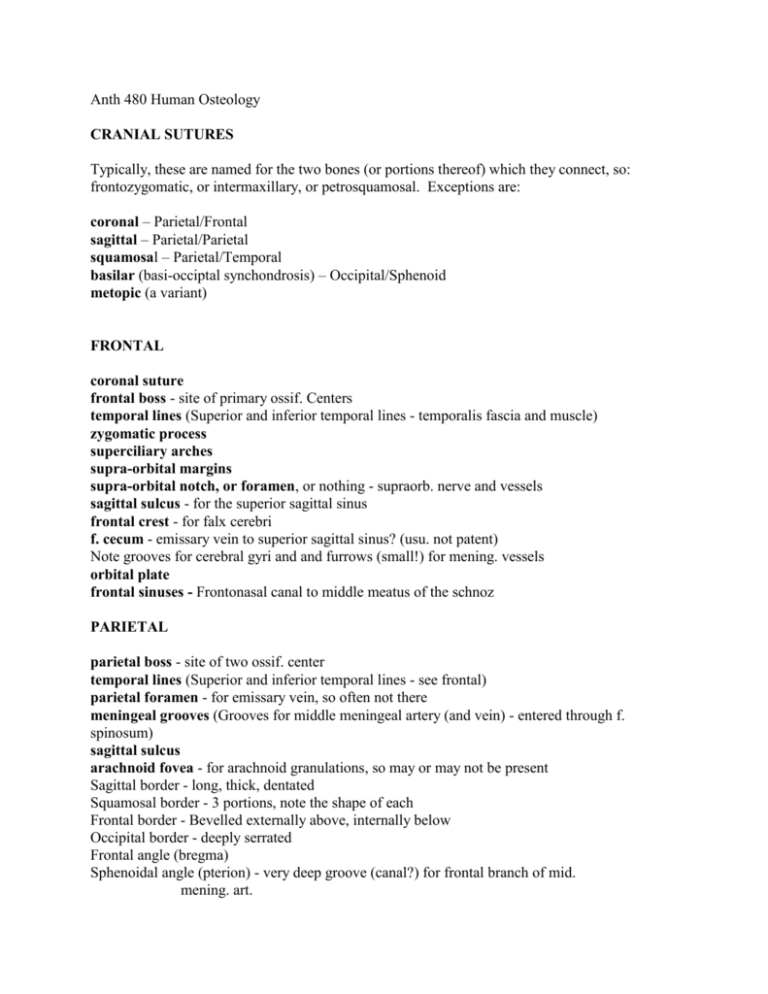
Anth 480 Human Osteology CRANIAL SUTURES Typically, these are named for the two bones (or portions thereof) which they connect, so: frontozygomatic, or intermaxillary, or petrosquamosal. Exceptions are: coronal – Parietal/Frontal sagittal – Parietal/Parietal squamosal – Parietal/Temporal basilar (basi-occiptal synchondrosis) – Occipital/Sphenoid metopic (a variant) FRONTAL coronal suture frontal boss - site of primary ossif. Centers temporal lines (Superior and inferior temporal lines - temporalis fascia and muscle) zygomatic process superciliary arches supra-orbital margins supra-orbital notch, or foramen, or nothing - supraorb. nerve and vessels sagittal sulcus - for the superior sagittal sinus frontal crest - for falx cerebri f. cecum - emissary vein to superior sagittal sinus? (usu. not patent) Note grooves for cerebral gyri and and furrows (small!) for mening. vessels orbital plate frontal sinuses - Frontonasal canal to middle meatus of the schnoz PARIETAL parietal boss - site of two ossif. center temporal lines (Superior and inferior temporal lines - see frontal) parietal foramen - for emissary vein, so often not there meningeal grooves (Grooves for middle meningeal artery (and vein) - entered through f. spinosum) sagittal sulcus arachnoid fovea - for arachnoid granulations, so may or may not be present Sagittal border - long, thick, dentated Squamosal border - 3 portions, note the shape of each Frontal border - Bevelled externally above, internally below Occipital border - deeply serrated Frontal angle (bregma) Sphenoidal angle (pterion) - very deep groove (canal?) for frontal branch of mid. mening. art. 2 Occipital angle (lambda) Mastoid angle (asterion) sigmoid sulcus - beginning thereof, or end of the transverse sulcus TEMPORAL squamous portion petrous portion external auditory meatus zygomatic process supramastoid crest, suprameatal crest - End of the line for the temporal line suprameatal triangle (and spine) - mastoid antrum is medial to this, but you can't see it parietal notch – know the shape of the sutures, where squamosal becomes parietomastoid suture mastoid process – Sternocleidomastoid muscle, also splenius and longissimus capitis mastoid foramen – for another emissary vein (and sometimes a branch of the occipital artery to the dura), so not always present digastric groove - for posterior belly of digastric muscle Tubercle of Taxman (juxtamastoid tubercle) occipital groove - for occip. artery, an end branch of ext. carotid articular eminence (or tubercle) mandibular fossa postglenoid process tympanic portion I'll have a tegmen tympani on squamotympanic fissure and petrotympanic fissure (hold the anterior canaliculus for the chorda tympani)(but seriously, "st" fissure is more anterior, "pt" more posterior, and you won't see the canaliculus) styloid process – for stylohyoid ligament, and muscles that start with “stylo” jugular fossa - int. jugular vein (and CN IX, X, XI) carotid canal - for the int. carotid artery grooves for the middle meningeal vessels – ultimately, the arterial branches trace back to the f. spinosum Internal auditory meatus - for 7th and 8th cranial nerves sigmoid sulcus (w/ thin lamina to mastoid air cells) trigeminal impression - for the ganglion arcuate eminence - anterior semicircular canal hiatus for the greater petrosal nerve - (the medial one) Branch of CN VII carrying preganglionic parasymps. to pterygopalatine ganglion hiatus for the lesser petrosal nerve - (the lateral one) Branch of CN IX w/ parasymps. to otic ganglion aqueductus vestibuli (or aqueduct of the vestibule for you less affected types) – for ductus endolymphaticus subarcuate fossa - Believe it or not, goes through age changes until about 4 years canaliculus cochlea (or cochlear canaliculus) - there are two other canaliculi which are so small we'll never find them groove for the superior petrosal sinus 3 canal for tensor tympani - (the superior one) auditory tube - (the inferior one) tympanic dehisence (F. of Huschke) - variation EAR OSSICLES malleus stapes incus OCCIPITAL foramen magnum external occipital protuberance superior nuchal line - medial 1/3 for trapezius, sternocleidomastoid (by aponeurosis) onto lateral 1/2, splenius capitis below lateral 1/3, semispinalis capitis and superior oblique (of the neck) between superior and inferior lines. inferior nuchal line - Rectus capitis posterior minor and major are between in. nuchal and f. magnum external occipital crest - for ligamentum nuchae basilar part occipital condyles condylar fossa and canal - canal is for emissary vein, so not always present hypoglossal canal - for CN XII, canal can be bridged if it wants too jugular process and notch - process is rough for rectus capitis lateralis cruciform eminence internal occip. protuberance sagittal sulcus - for the superior sagittal sinus internal occipital crest transverse sulcus MAXILLA alveolar process zygomatic process infraorbital foramen - for branch of V2 anterior nasal spine infraorbital sulcus, leading to canal, to foramen maxillary sinus frontal process anterior lacrimal crest – posterior crest is on the lacrimal itself palatine process incisive foramen – doesn’t really go anywhere, so sometimes called a fossa, but there’s already 4 an incisive fossa incisive canal – continuous up to the floor of the piriform aperture groove which becomes greater palatine canal once you add in the perp. plate of palatine incisive fossa, canine eminence, canine fossa PALATINE horizontal plate greater palatine foramen posterior nasal spine lesser palatine foramina perpendicular plate pyramidal process (that which sticks twixt the pterygoid plates) VOMER alae perpendicular plate INFERIOR NASAL CONCHA Has three processes (lacrimal, ethmoidal, and maxillary) which will have broken off by the time you see this bone. To know how it "sits" is to know how to side it. ETHMOID cribriform plate - for CN I crista galli - end of falx cerebri perpendicular plate - artics. w/ nasal spine of frontal and crest of nasal bones, sphenoidal crest and vomer, septal cartilage Orbital plate (or lamina paperycia) LACRIMAL posterior lacrimal crest NASAL foramen for a small vein ZYGOMATIC frontal process temporal process 5 maxillary process zygomaticofacial foramen (mina?) - for exit of nerve of same name zygomaticoorbital foramen (mina?) - for entrance of branches of zygomatic nerve (those being zygomaticofacial and zygomaticotemporal) zygomaticotemporal foramen - for exit of nerve of same name SPHENOID body optic canal – for CN II sella turcica – looks like a Turkish saddle? hypophyseal fossa – for the pituitary, a.k.a. the hypophysis dorsum sellae, with posterior clinoid processes sphenoidal sinuses greater wings superior orbital fissures – twixt greater and lesser wings, for passage of a lot of stuff (CN III, IV, V1, and VI, veins to cavernous sinus) foramen rotundum – round, for passage of V2 foramen ovale – oval, for passage of V3 foramen spinosum – by the spine, for passage of middle meningeal artery infratemporal crest - division between temporal fossa (w/ temporalis muscle) and infratemporal fossa (w/ lateral pterygoid muscle) lesser wings anterior clinoid processes, and between anterior and posterior is the tuberculum sellae, with middle clinoid processes pterygoid processes, with medial and lateral pterygoid plates pterygoid fossa – for medial pterygoid muscle, and note scaphoid fossa for tensor veli palatini, which hooks around the… pterygoid hamulus pterygoid canals – for the nerve of the pterygoid canal MANDIBLE body mental foramen – for mental nerves (end of the line for inferior alveolar) mylohyoid line – for muscle of same name, sublingual fossa is above, submandibular is below (glands of same names reside in these fossae) mandibular torus – like palatine, may or may not be present mental or mandibular symphysis mental spines (or genial tubercles) – for genioglossus and geniohyoid muscles digastric fossa - for insertion of ant. belly of digastric, but usually pretty hard to see mental protuberance - or chin, if you will mental tubercles - to either side ascending ramus 6 mandibular condyle - artics. w/ temporal, note that most of it lies medially condylar neck, with pterygoid fovea for lateral pterygoid coronoid process - for temporalis muscle, note internal "ridge" for muscle (White calls this the "endocoronoid ridge" or "butress") mandibular notch gonial angle – note attachment area for medial pterygoids internally (White calls these “pterygoid tuberosities”), and some “lumpy bumpies” externally for masseter (While calls these the “masseteric tuberosity”) mandibular foramen (leading into canal) – for inferior alveolar nerve lingula - for sphenomandibular ligament (from spine of sphenoid) mylohyoid groove - for nerve of same name (branch of V3) going to ant. belly of digastric and mylohyoid muscle HYOID body - attachment for many muscles with the term "hyoid" in them (geniohyoid, stylohyoid, omohyoid, mylohyoid, sternohyoid) greater wing – which means there must be a lesser, but you aren’t likely to see much of it THYROID CARTILAGE Usually a cartilage, and hence not directly of osteological interest, but can ossify. Other laryngeal cartiages (arytenoids and cricoid) can also ossify, but do so later in life. TEETH Know them, love them (both deciduous and permanent)
